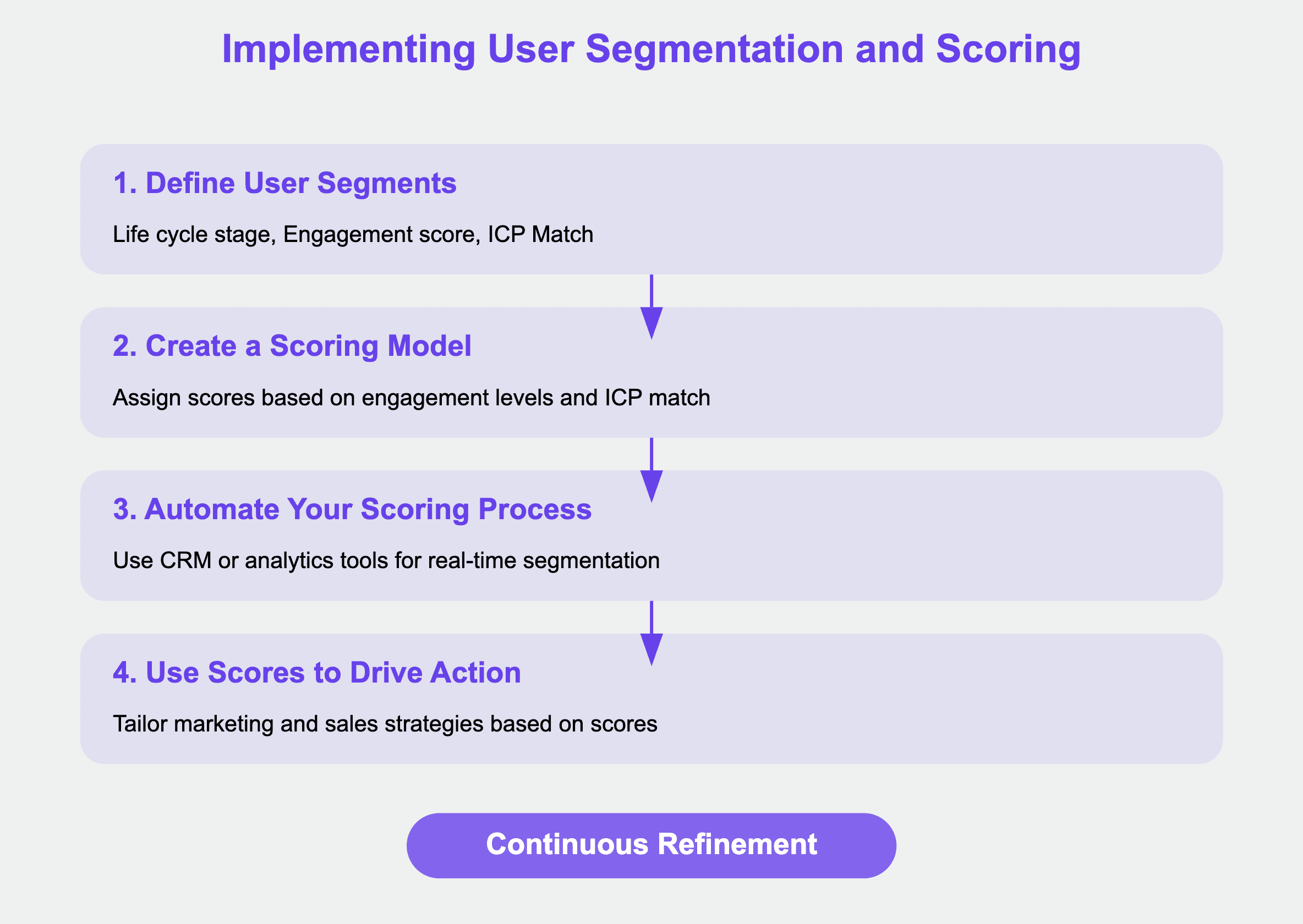
User Segmentation and Scoring: Short Guide for B2B SaaS

par
François Lecomte
7 oct. 2024
Identifiez et convertissez vos utilisateurs les plus importants
Créer un compte
Understanding your users is crucial for success. One of the best ways to gain that understanding is through user segmentation and scoring. By dividing your user base into segments and assigning scores based on their engagement, you can more effectively target marketing efforts, improve product experiences, and prioritize high-value customers.
In this blog post, we’ll explore the basics of user segmentation and scoring, why it’s important for B2B SaaS businesses, and how to implement it to boost your customer acquisition and retention strategies.
What Is User Segmentation?
User segmentation refers to the process of dividing your users into distinct groups based on certain characteristics or behaviors. For B2B SaaS businesses, the most common way to segment users is by analyzing their engagement with your product or website. Engagement is a powerful indicator of how invested users are in your solution, and it can help you determine which users are likely to convert, renew, or churn.
The Basics of User Scoring
User scoring builds on segmentation by assigning a numerical value, or score, to each user based on their behavior and engagement. This score helps you quickly assess the quality of each user or lead, allowing your marketing teams to focus their efforts on the highest-value opportunities.
There are several methods to implement user segmentation and scoring for B2B SaaS businesses, but the easiest and most effective is based on engagement metrics.
Key Metrics for User Engagement Scoring

User engagement scoring is typically calculated using a range of activity-based metrics. Here are some of the most important ones:
1. Session Time
The amount of time a user spends on your website or within your product is a strong indicator of engagement. Users who stay longer are generally more interested in what you have to offer. Session time can give you a sense of how much value users are getting from your solution.
2. Login Frequency
How often users log into your platform can reveal their level of commitment. Frequent logins usually indicate a user who is actively using the product and is likely more engaged. Conversely, a drop in login frequency may signal disengagement or a potential churn risk.
3. Feature Usage
Tracking which features users interact with can tell you a lot about their needs and how they’re using your product. High engagement with core features is a sign that users are finding value, while low engagement might indicate confusion or a lack of fit.
4. Page Views and Clicks
The number of pages a user visits or the actions they take on your website can provide insights into their interest level. For example, if a user is exploring pricing pages, case studies, or signing up for a demo, they’re likely more serious about becoming a paying customer.
How to Implement User Segmentation and Scoring

If you're ready to leverage user segmentation and scoring to improve your B2B SaaS business, here’s a step-by-step approach:
1. Define Your User Segments
Start by identifying the key segments within your user base. An efficient segmentation strategy includes:
Life cycle stage: Separate those who are just visiting your website anonymously from those who have signed up, and the ones who are paying customers.
Engagement score: Segment users based on their interaction with the key features of your product, taking into account the time they spend using it.
ICP Match: Separate the users who actually fit with your Ideal Customer Profile from the ones who are probably not the best customers for your business..
2. Create a Scoring Model
Once you’ve identified your key metrics, assign scores to different levels of engagement. A user who logs in daily and spends more than 30 minutes on your platform should receive a higher score than a user who logs in once a week for five minutes.
Define your ideal customer profile(s), and use data enrichment and onboarding questions to compute an ICP match score of your users.
3. Automate Your Scoring Process
Many customer relationship management (CRM) platforms or SaaS-specific analytics tools allow you to automate user segmentation and scoring. By setting up automated workflows, you can make this process seamless and segment users in real-time.
5. Use Scores to Drive Action
Finally, put your user scores to work by tailoring your marketing and sales strategies accordingly. For example:
High-Scoring Leads: Focus your sales team’s efforts on high-scoring leads who are most likely to convert.
Low-Engagement Users: Set up automated re-engagement campaigns to bring these users back to your platform.
Trial Users Near Conversion: For users scoring high during a free trial, offer them personalized outreach or incentives to upgrade.
The Benefits of User Segmentation and Scoring
Implementing a user segmentation and scoring system offers a range of benefits for B2B SaaS businesses, including:
Personalized Marketing: With segmented user data, you can tailor your marketing efforts to match the needs of each group, boosting engagement and conversion rates.
Proactive Retention Strategies: By identifying users who are becoming disengaged, you can implement retention campaigns before they churn, increasing customer lifetime value.
Conclusion
User segmentation and scoring are powerful tools for B2B SaaS businesses looking to optimize their marketing and customer success strategies. By leveraging key engagement metrics and creating a scoring model, you can gain a clearer understanding of your users, prioritize high-value opportunities, and build stronger relationships with your customers. Implementing a smart segmentation and scoring strategy can make all the difference in driving growth and retention.




